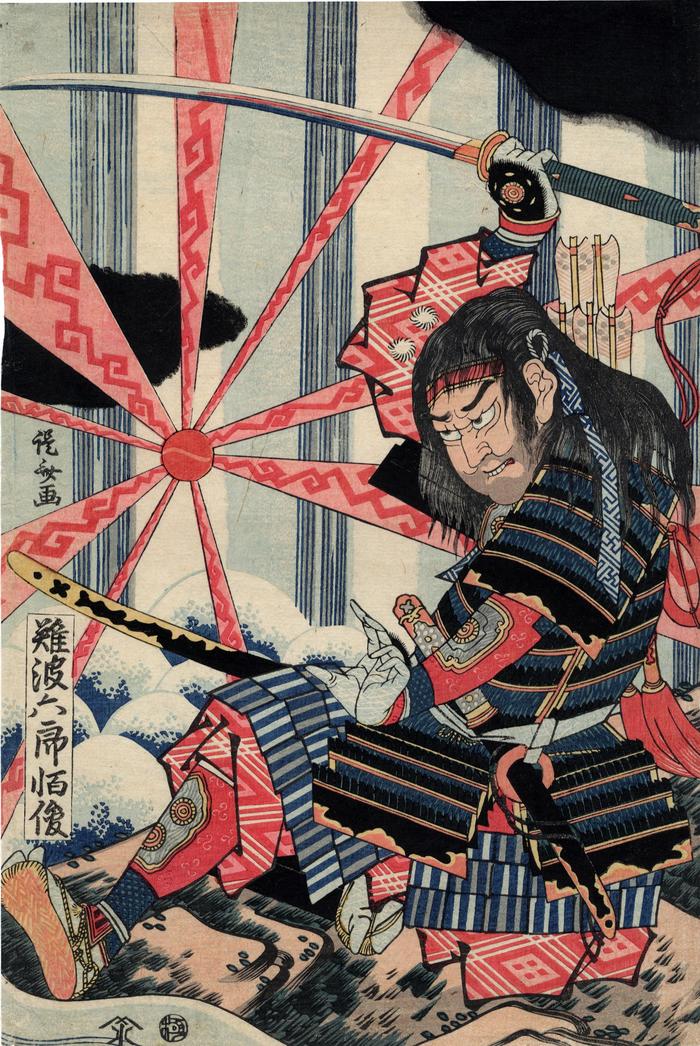Teisai Hokuba (蹄斎北馬) (artist 1771 – 1844)
Nanba Rokurō Tsunetō (難波六郎) at Nunobiki Falls - the bottom half of a vertical diptych referred to as 'The Ghost (Rei) of Akugenda Yoshihira
ca 1830
9.75 in x 14.75 in (Overall dimensions) Japanse color woodblock print
Signed: Teisai ga (蹄斎画)
Publisher: Daikokuya
(Marks U032 - seal 02-043)
Censor seal: kiwame
Museum of Fine Arts, Boston
Museum of Fine Arts, Boston - an early Hokusai, signed Shunrō, ca. 1781, of this same character seen against a waterfall
Museum of Fine Arts, Boston - 1843-47 Yoshitsuya triptych of Nanba Rokurō Tsunetō visiting the Dragon King's palace
Lyon Collection - Kuniyoshi print related to this theme Very few of Hokuba's images, either painted or produced as ukiyo prints, represent warriors or musha as in this example. That is what makes this print in the Lyon Collection so special - especially considering what must be viewed as its nearly pristine coloration.
****
The Theme
Nanba, a ruffian, played a role in the Tale of Heike and in some accounts he was one of Taira no Kiyomori's henchmen.
Nanba Rokurō Tsunetō is one of the main characters in a play entitled Sakigake Genji no kiba musha which was performed at the Kawarazaki in the 11th month of 1828. Ichikawa Danjūrō VII acted in this role. In the curatorial notes from the Fitzwilliam Museum it notes that this was "One of many plays based on the Gempei seisuiki (Account of the Gempei wars) and Heike monogatari (Tales of the Heike), involving incidents from the wars between the Heike and Genji clans in the 12th century."
His character also plays a role in Genpei Nunobiki. That piece was originally written for the puppet theater in 1749. It was adapted to the kabuki theater in 1751.
Of Act I: scene 2 of that play Kabuki21 writes:
The scene is set in Settsu at the Nunobiki Falls. By order of Kiyomori, who has been told by a goddess in a dream that the fortune of the Heike Clan will be told by the witch living at the bottom of the Nunobiki Falls, the warrior Nanba Rokurô Tsunetoshi comes to the front of the waterfall. Taira no Shigemori, Taira no Kiyomori's son, also arrives, accompanied by Takahashi Hangan Nagatsune, to observe Tsunetoshi's actions.*Note: Tsuntoshi is another reading of Tsunetō
Soon after Tsunetoshi has dived into the waterfall basin an arrow apparently aimed at Shigemori swishes by him. Retainers of Shigemori soon arrest the archer and bring him to Shigemori. Nagatsune says that the would-be assassin is the Genji warrior Tada no Yukitsuna, in disguise of a hunter, but Shigemori magnanimously frees him.
Presently Tsunetoshi comes back from the bottom of the waterfall basin to report that the witch is very angry at Kiyomori's arrogance. No sooner has he finished reporting than a tremendous thunder storm occurs probably an indication that the witch is displeased with Tsunetoshi's disclosure of her secret.
****
In a description of this scene in Iwakiri and Newland's 2013 book on Kuniyoshi, in reference to the Kuniyoshi triptych from ca. 1830, related to this scene, it says:
Minamoto no Yoshitomo's elder son Minamoto no Yoshihira (1140-1160) was also known by the name Akugenda Yoshihira. Defeated in the Heiji rebellion in 1160, he was decapitated at Rokujōgawara by Nanba Tsunefusa. Yoshihira's last words were 'Without fail, I will become a thunderbolt and strike you dead'. In 1168, Nanba accompanies Tairo no Kiyomori (1118-1181) on a visit to the Nunobiki waterfall; there is a sudden clap of thunder and exactly as Yoshihira vowed years earlier the thunder strikes and kills Nanba. This account is found in the Heiji mongatari (Tales of Heiji...
warrior prints (musha-e - 武者絵) (genre)
Daikokuya (大黒屋) (publisher)
